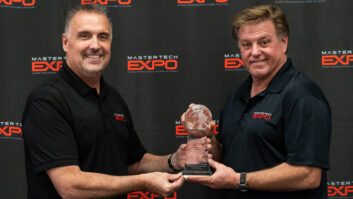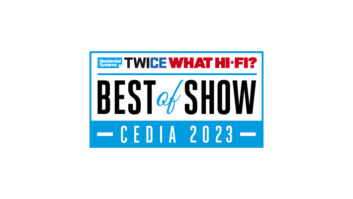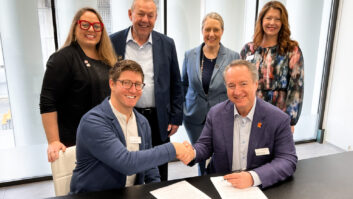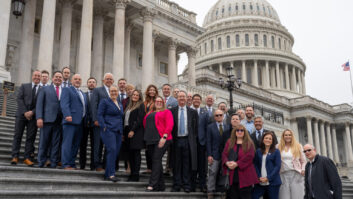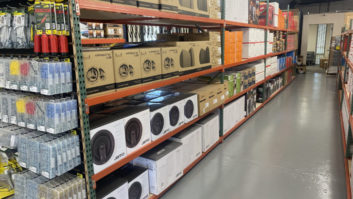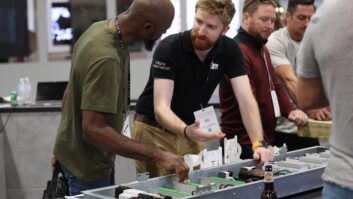New York — Sony chairman/CEO Sir Howard Stringer joined Best Buy vice chairman/CEO Brad Anderson in the final segment of their CEO Exchange program, to be aired later this year on PBS.
The show featured a lively repartee between the two executives and host, noted TV journalist Jeff Greenfield.
When asked by Greenfield what their greatest challenges are, Stringer commented on two sides of Sony’s business. “With content — music and movies — how do we sell it? How do we make devices for new content? And how do you keep Sony a premium brand [in electronics] during an age of commoditization?”
He added, “I’m not complaining, it is very, very exciting this … ever-changing chaos of the market.”
Stringer later noted, “You can’t be complacent. I visited Sony Ericsson and felt good about their performance. Then one of their engineers came over to me and said we were two years behind in a key technology. So sometimes you are in a perpetual state of panic.”
Anderson said one of his challenges is that “it is possible to hear from more people than you ever heard from before. You have to figure out how to listen to the best ideas of 120,000 [Best Buy] employees. You have to listen to the best ideas … and bridge the gap between the executive suite and the store level.”
Greenfield asked both executives how they can predict which new products will or will not be accepted by consumers. Anderson commented that sometimes when a product fails at Best Buy, “Sometimes it is us. Sometimes we are not presenting the product’s full benefits. But we can’t always tell which product will be hot and which won’t.”
Stringer said as chairman of Sony, with the thousands of products the company makes, even he has a hard time keeping track. “I’ve bought one of our digital cameras only to find out the next day that there is a new model with improved features.” He mentioned the Sony technology fair that features existing products and prototypes which is “amazing … when you see the number and variety of products.”
Stringer added that in order to introduce CE products today, it is a must to “listen to consumers. In the analog days you could just produce boxes. Now you have to listen … which is much harder.”
When asked how retailers and suppliers work together on new products before they come to market, Anderson said while Best Buy doesn’t play an active role in that area, “We have gained a deeper understanding of [suppliers’] market concerns are. In the past, our organization had an adversarial relationship [with suppliers].” To which Stringer turned to the audience and quickly quipped, “And I don’t like him either,” which generated plenty of laughter.
Greenfield then brought out a copy of a Best Buy ad in a recent issue of USA Today featuring Samsung products and asked how retailers have to balance their relationships with a variety of suppliers.
With insight and his trademark wit, Stringer replied, “It is a realistic relationship. [Brad and I] have a good relationship. And I understand that it is his job to also sell that wretched Samsung product,” a comment that again garnered laughs from the audience.
He then said, “I have stores, not many, 40 in the U.S. Years ago [Sony executives] told us, ‘You can’t have stores here. The retailers will resent it.’ On the other hand retailers sell cheap Chinese products and we can’t do a thing.”
Stringer explained that Sony Stores are “not really competitors [with retailers] since we sell product at higher prices, keep our brand presence alive … and refer many of our customers to Best Buy.”
The Sony chairman also said that both companies have the same concern about packaged media. “Best Buy sells plenty of our packaged media. We produce them, [pointing to Brad] you sell them and you [turning to the audience] steal them!” He then noted, “Our relationship is helpful and not adversarial.”
When asked the proverbial crystal ball question of what’s next on the technology horizon, Stringer noted, “There are variations on a theme here. You will see more Web content and video going directly to the TV without a PC, like our BRAVIA Web product. You will see content being paid for once and being able to be moved around the home, to TVs, PCs and the cellphone.”
Anderson gave Stringer his final straight line of the program, “We have more technology than we know what to do with. We need more ease of use. That’s what the iPod did,” and he turned to Stringer and said, “Sorry to say.”
The Sony chairman immediately cut in, turned to the audience and said, “CircuitCity doesn’t give me these types of problems.”





